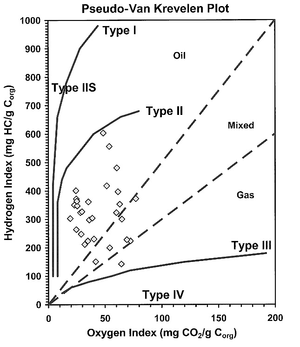Difference between revisions of "Type I kerogen"
Jump to navigation
Jump to search

(Created page with "Highly oil-prone organic matter having Rock-Eval pyrolysis hydrogen indices greater than 600 mg hydrocarbon\g TOC when thermally immature; contains algal and b...") |
|||
| (3 intermediate revisions by the same user not shown) | |||
| Line 1: | Line 1: | ||
| − | Highly oil-prone organic matter having [[Rock-Eval pyrolysis]] [[hydrogen]] indices greater than 600 mg [[hydrocarbon]]\g [[TOC]] when thermally immature; contains algal and bacterial input dominated by amorphous [[liptinite]] [[maceral]]s; common in both [[marine]] and [[lacustrine]] settings; type I pathway on [[Van Krevelen | + | [[File:VanKrevelanDiagram.png|thumb|300px|Van Krevelen diagram.<ref>Dembicki, H., 2009, [http://archives.datapages.com/data/bulletns/2009/03mar/BLTN08076/BLTN08076.HTM Three common source rock evaluation errors made by geologists during prospect or play appraisals]: AAPG Bulletin, vol. 93, issue 3, pp. 341-356.</ref>]] |
| + | |||
| + | Highly oil-prone organic matter having [[Rock-Eval pyrolysis]] [[hydrogen]] indices greater than 600 mg [[hydrocarbon]]\g [[total organic carbon (TOC)|TOC]] when thermally immature; contains algal and bacterial input dominated by amorphous [[liptinite]] [[maceral]]s; common in both [[marine]] and [[lacustrine]] settings; type I pathway on [[Van Krevelen diagram]]s.<ref name=Petersetal_2012>Peters, Kenneth E., David J. Curry, and Marek Kacewicz, 2012, [http://archives.datapages.com/data/specpubs/hedberg4/INTRODUCTION/INTRODUCTION.HTM An overview of basin and petroleum system modeling: Definitions and concepts], ''in'' Peters, Kenneth E., David J. Curry, and Marek Kacewicz, eds., Basin modeling: New horizons in research and applications: [http://store.aapg.org/detail.aspx?id=1106 AAPG Hedberg Series no. 4], p. 1-16.</ref> | ||
{{stub}} | {{stub}} | ||
| + | |||
| + | ==See also== | ||
| + | * [[Kerogen]] | ||
| + | * [[Type II kerogen]] | ||
| + | * [[Type IIS kerogen]] | ||
| + | * [[Type III kerogen]] | ||
| + | * [[Type IV kerogen]] | ||
==References== | ==References== | ||
{{reflist}} | {{reflist}} | ||
| + | |||
| + | [[Category:Stubs]] | ||
Latest revision as of 21:06, 6 July 2015

Van Krevelen diagram.[1]
Highly oil-prone organic matter having Rock-Eval pyrolysis hydrogen indices greater than 600 mg hydrocarbon\g TOC when thermally immature; contains algal and bacterial input dominated by amorphous liptinite macerals; common in both marine and lacustrine settings; type I pathway on Van Krevelen diagrams.[2]
This article is a stub. You can help AAPG Wiki by expanding it.
See also
References
- ↑ Dembicki, H., 2009, Three common source rock evaluation errors made by geologists during prospect or play appraisals: AAPG Bulletin, vol. 93, issue 3, pp. 341-356.
- ↑ Peters, Kenneth E., David J. Curry, and Marek Kacewicz, 2012, An overview of basin and petroleum system modeling: Definitions and concepts, in Peters, Kenneth E., David J. Curry, and Marek Kacewicz, eds., Basin modeling: New horizons in research and applications: AAPG Hedberg Series no. 4, p. 1-16.